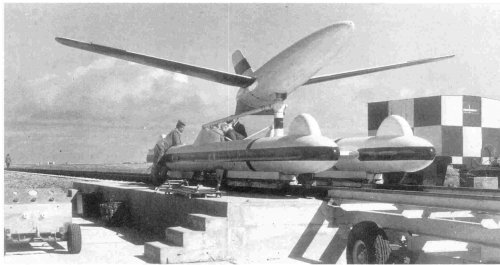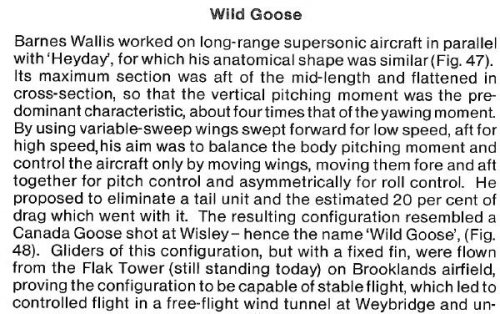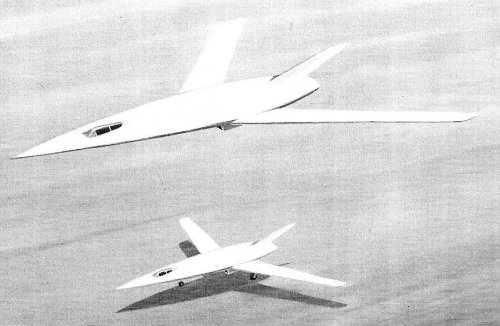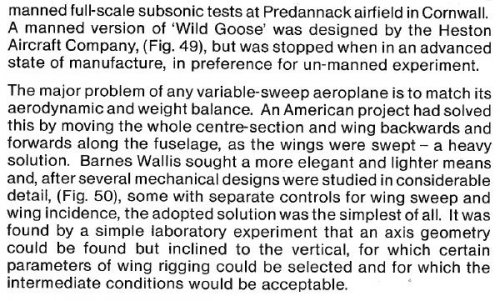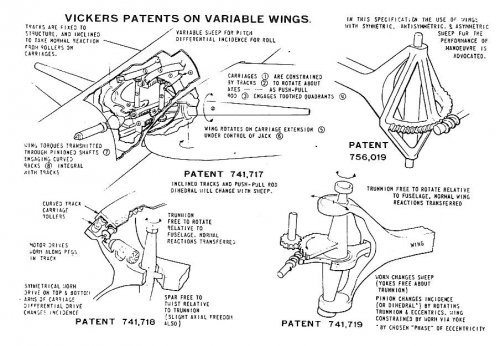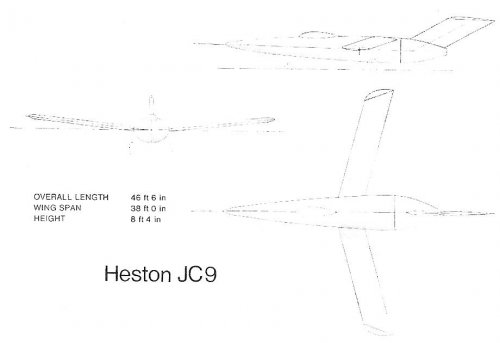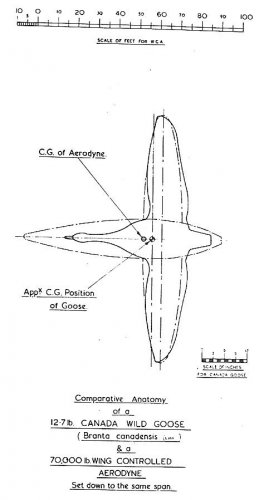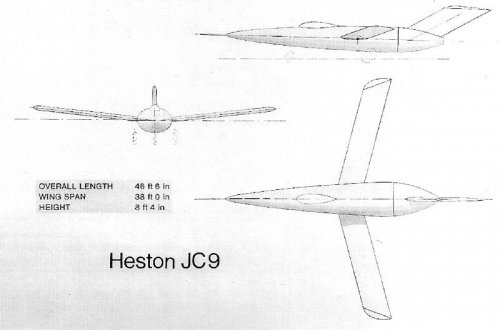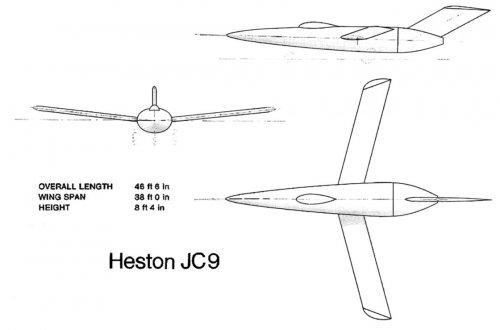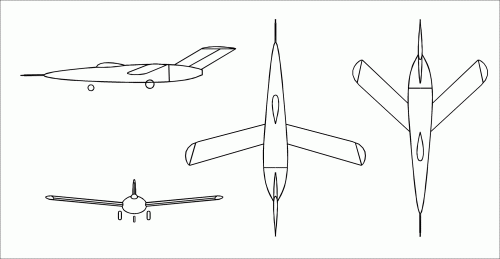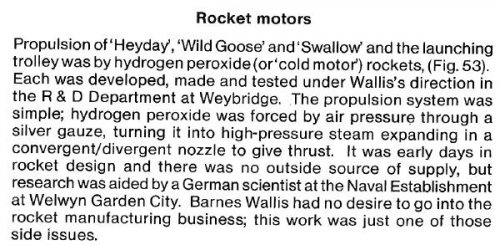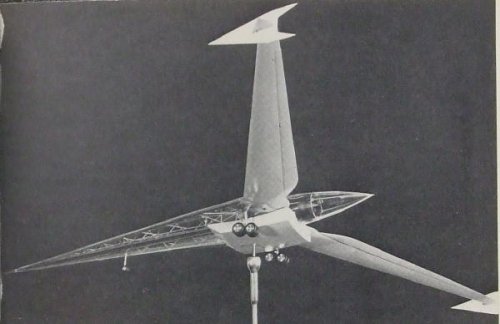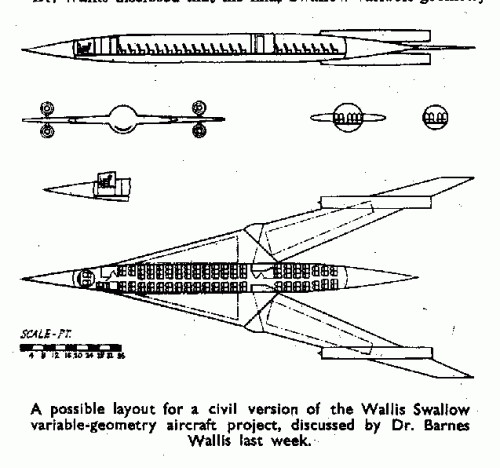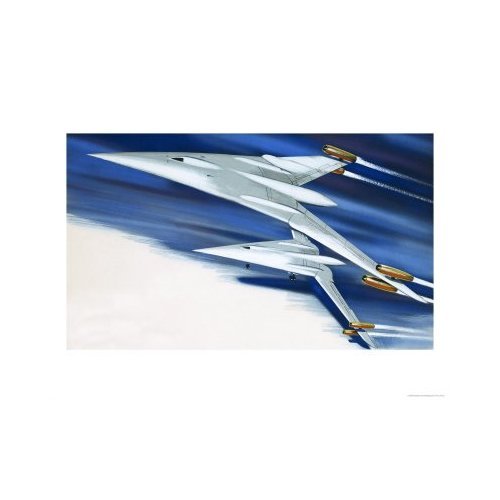You are using an out of date browser. It may not display this or other websites correctly.
You should upgrade or use an alternative browser.
You should upgrade or use an alternative browser.
Barnes Wallis Wild Goose / Swallow
- Thread starter hesham
- Start date
red admiral
ACCESS: Top Secret
- Joined
- 16 September 2006
- Messages
- 1,816
- Reaction score
- 2,403
Having finished reading a biography of Barnes Wallis I was wondering whether anyone had pictures of the Wild Goose or Swallow flying models? The actual big radio controlled ones rather than the smaller "airfix" representations.
Thanks
Thanks
- Joined
- 11 March 2006
- Messages
- 8,627
- Reaction score
- 3,816
This one's from Derek Wood "Project Cancelled", showing the
Wild Goose on its trolley.
(Other Barnes Wallis designs : http://www.secretprojects.co.uk/forum/index.php/topic,468.msg3300.html#msg3300 )
Wild Goose on its trolley.
(Other Barnes Wallis designs : http://www.secretprojects.co.uk/forum/index.php/topic,468.msg3300.html#msg3300 )
Attachments
hesham said:Thank you dear Chuck,
Anther aircraft I know it but I am asking about which specification it was designed for;
it was the Heston JC.9.
I believe the Heston JC9 was a 'scale' trials aircraft manufactured for Vickers in connection with the Swallow swing wing project. It was delivered but not assembled / flown. I've never found any pictures or specification. Does anyone know more?
Fred
Wonderfull information, as usual, Mr Bond!
Any chance of a better scan of the Heston 3 view?
I seem to recall reading that this aircraft was made out of wood and was crated ready for shipment to Vickers when the project was stopped.
Does anyone know of any pictures?
Regards
Fred
Any chance of a better scan of the Heston 3 view?
I seem to recall reading that this aircraft was made out of wood and was crated ready for shipment to Vickers when the project was stopped.
Does anyone know of any pictures?
Regards
Fred
Not really the photocopy is faint -when I can get to the library again I'll try a darker setting.
- Joined
- 11 March 2006
- Messages
- 8,627
- Reaction score
- 3,816
No CAD, just a quick attempt with Corel Draw ...
The wheel positions seem to be shown on the ground and in the air,
on the original drawing that would indicate a fixed undercarriage and
then it probably was a glider, I think. ???
If we have no further "hard" informations, I would use the undercarriage
of the A2/45 as a pattern. Would the JC-9 have had a swivelling wing
at all, or would it jus have been a testbed fo low-speed configuration ?
The wheel positions seem to be shown on the ground and in the air,
on the original drawing that would indicate a fixed undercarriage and
then it probably was a glider, I think. ???
If we have no further "hard" informations, I would use the undercarriage
of the A2/45 as a pattern. Would the JC-9 have had a swivelling wing
at all, or would it jus have been a testbed fo low-speed configuration ?
Attachments
- Joined
- 11 March 2006
- Messages
- 8,627
- Reaction score
- 3,816
I think, the JC-9 was intended for similar purposes, as the Shorts S.B.5,
which had a fixed landing gear, too. Question is, if the swept back wing
position would have been useful then.
which had a fixed landing gear, too. Question is, if the swept back wing
position would have been useful then.
Derek Wood in his Project Cancelled says it was a small experimental variable geometry aircraft. It was built in sections by Heston Iarcraft and shipped to Weybridge but never assembled and eventually scrapped 
Regards,
Barry
Regards,
Barry
amsci99 wrote:
Wallis developed an aircraft shape that was specifically designed to reduce radar reflection - the subject of a patent filed in autumn 1954. Rather than go for angular, he went for an elliptical cross-section, but arranged such that only a small part of the fuselage would reflect normal to the surface, unless directly overhead the radar station.
Go to gb.espacenet.com and do an Advanced Search for GB852881 to see the patent document.
Regards,
Iain.
The flying banana reminds me of one of Barnes Wallis's later designs. Does the scallop wings reduce RCS?
Wallis developed an aircraft shape that was specifically designed to reduce radar reflection - the subject of a patent filed in autumn 1954. Rather than go for angular, he went for an elliptical cross-section, but arranged such that only a small part of the fuselage would reflect normal to the surface, unless directly overhead the radar station.
Go to gb.espacenet.com and do an Advanced Search for GB852881 to see the patent document.
Regards,
Iain.
pometablava said:BTW, didn't knew about the pop-up cockpit design
It's an ugly solution, but it makes a measure of sense. Aerodynamically a nightmare, and of course it means that the cockpit pretty much has to be a separate pressure vessel from the passenger cabin.
That thing would not have survived the stoppage of one of its engines!
zerstorer1946
ACCESS: Confidential
- Joined
- 27 January 2009
- Messages
- 58
- Reaction score
- 5
BIG WOW  very very nice!
very very nice!
great work.
 ;D
;D 
great work.
shockonlip
ACCESS: Top Secret
- Joined
- 29 January 2008
- Messages
- 605
- Reaction score
- 57
Pretty slick !!
saturncanuck
Any landing you can walk away from, is a good one.
Yes, I've seen the Swallow before. And the cockpit design. In RAF Hendon they have a reproduction of Wallis' office and the Swallow model is there.
I am sure many features would have changed on the production aircraft, but an inspired design.
I am sure many features would have changed on the production aircraft, but an inspired design.
pometablava said:Great work Scott. It's a beauty.
BTW, didn't knew about the pop-up cockpit design
- Joined
- 11 March 2006
- Messages
- 8,627
- Reaction score
- 3,816
zerstorer1946
ACCESS: Confidential
- Joined
- 27 January 2009
- Messages
- 58
- Reaction score
- 5
cool , was this conidered as a bomber, or just solely as an airliner??
how cool would it look in camo!
how cool would it look in camo!
- Joined
- 11 March 2006
- Messages
- 8,627
- Reaction score
- 3,816
That's the civil version, the bomber had the cockpit further aft.
(see http://www.secretprojects.co.uk/forum/index.php/topic,468.15.html)
And the model was in "nuclear lightning white "
(see http://www.secretprojects.co.uk/forum/index.php/topic,468.15.html)
And the model was in "nuclear lightning white "
saturncanuck
Any landing you can walk away from, is a good one.
Wow, I had no idea he was woking on a bomber version.
hole in the ground
ACCESS: Secret
- Joined
- 6 August 2008
- Messages
- 235
- Reaction score
- 23
I guess the CG changes along with the AC due to the wingtip mounted engines... quite clever really.
Scott,
Agree with you that it's an ugly solution, I believe the engines have to swivel as well along with the wings. What was Barnes thinking or was he still stuck in his 'bouncing bomb' frame of mind? However, I would not disagree that this British quirkiness does not have it's appeal, wouldn't look out of place on any of Gerry Anderson's shows.
Agree with you that it's an ugly solution, I believe the engines have to swivel as well along with the wings. What was Barnes thinking or was he still stuck in his 'bouncing bomb' frame of mind? However, I would not disagree that this British quirkiness does not have it's appeal, wouldn't look out of place on any of Gerry Anderson's shows.
saturncanuck
Any landing you can walk away from, is a good one.
Yes, but wasn't the "Fireflash" pne of the most beautiful airliners?
amsci99 said:Scott,
Agree with you that it's an ugly solution, I believe the engines have to swivel as well along with the wings. What was Barnes thinking or was he still stuck in his 'bouncing bomb' frame of mind? However, I would not disagree that this British quirkiness does not have it's appeal, wouldn't look out of place on any of Gerry Anderson's shows.
Hi all,
I've been doing a lot of research on Swallow recently for my forthcoming book on Wallis:
http://www.amazon.co.uk/Bouncing-Bomb-Man-Science-Barnes-Wallis/dp/1844255883/ref=sr_1_1?ie=UTF8&s=books&qid=1240313149&sr=8-1
So I hope I can answer some of the recent questions in this thread about Swallow.
There were many versions of Swallow which were taken to varying levels of development, from outline plans to flying models. Manned versions included a single-seater proof-of-concept research aircraft through bomber versions (including one to OR.339 which could have become TSR.2) to airliner versions including the one in the kit and an eight-engined double-deck airliner.
A fundamental concept of the Swallow was that it had NO TAIL (to save weight and drag) and NO CONTROL SURFACES anywhere - the wings were in one single piece for strength, and the engine cluster was gimballed in three dimensions to act as rudder, ailerons and elevators. The one error in the Fantastic Plastic model is that it shows elevators on the rear of the wings (which some versions with fuselage-mounted engines did have, but not the wing-mounted engine versions) and also wingtip control surfaces (which no version ever had). If you get the model, fill these grooves in with putty!!!
This is one of the main objections levelled at the design, both at the time and by modern aerodynamicists. In the swept configuration, the engines are so close to the centreline that an engine-out is not a problem. In the unswept configuration, it is potentially a big deal, but Wallis designed an automatic (mechanical) sensor which looked for equal thrust from both wings. If imbalance was detected, the engines on the working side were set to "toe-in" which reduced the thrust on that side and restored the thrust line to within a manageable region. This would have worked within half a second, before the pilot even spotted the engine-out. Wallis got a patent for this, but how well it would have worked in practice is anyone's guess!
Swallow would have had a nose-up landing attitude like Concorde, and Wallis did occasionally use the Concorde-type "droop nose", but usually went for the pop-up cockpit idea, either a rise-fall one like that seen on the model here, or one with the crew in tandem, which was hinged at the back and only rose up at the front. Some of the Swallows (e.g. OR.339) had a conventional fixed or bubble cockpit, though this had aerodynamic disadvantages.
Some of the Swallow designs are truly beautiful aircraft (even better than Concorde), but I agree that the Fireflash takes some beating ... Wallis never put the crew in the tail (usually he had no tail!) and didn't use nuclear power either! Thunderbird 1 did have variable-geometry wings, but by 1964, VG was almost de rigueur in aircraft design anyway.
Regards,
Iain M.
I've been doing a lot of research on Swallow recently for my forthcoming book on Wallis:
http://www.amazon.co.uk/Bouncing-Bomb-Man-Science-Barnes-Wallis/dp/1844255883/ref=sr_1_1?ie=UTF8&s=books&qid=1240313149&sr=8-1
So I hope I can answer some of the recent questions in this thread about Swallow.
There were many versions of Swallow which were taken to varying levels of development, from outline plans to flying models. Manned versions included a single-seater proof-of-concept research aircraft through bomber versions (including one to OR.339 which could have become TSR.2) to airliner versions including the one in the kit and an eight-engined double-deck airliner.
A fundamental concept of the Swallow was that it had NO TAIL (to save weight and drag) and NO CONTROL SURFACES anywhere - the wings were in one single piece for strength, and the engine cluster was gimballed in three dimensions to act as rudder, ailerons and elevators. The one error in the Fantastic Plastic model is that it shows elevators on the rear of the wings (which some versions with fuselage-mounted engines did have, but not the wing-mounted engine versions) and also wingtip control surfaces (which no version ever had). If you get the model, fill these grooves in with putty!!!
That thing would not have survived the stoppage of one of its engines!
This is one of the main objections levelled at the design, both at the time and by modern aerodynamicists. In the swept configuration, the engines are so close to the centreline that an engine-out is not a problem. In the unswept configuration, it is potentially a big deal, but Wallis designed an automatic (mechanical) sensor which looked for equal thrust from both wings. If imbalance was detected, the engines on the working side were set to "toe-in" which reduced the thrust on that side and restored the thrust line to within a manageable region. This would have worked within half a second, before the pilot even spotted the engine-out. Wallis got a patent for this, but how well it would have worked in practice is anyone's guess!
Swallow would have had a nose-up landing attitude like Concorde, and Wallis did occasionally use the Concorde-type "droop nose", but usually went for the pop-up cockpit idea, either a rise-fall one like that seen on the model here, or one with the crew in tandem, which was hinged at the back and only rose up at the front. Some of the Swallows (e.g. OR.339) had a conventional fixed or bubble cockpit, though this had aerodynamic disadvantages.
Some of the Swallow designs are truly beautiful aircraft (even better than Concorde), but I agree that the Fireflash takes some beating ... Wallis never put the crew in the tail (usually he had no tail!) and didn't use nuclear power either! Thunderbird 1 did have variable-geometry wings, but by 1964, VG was almost de rigueur in aircraft design anyway.
Regards,
Iain M.
methinks more a parameter study by Wallis's office at Brooklands suggesting that a design of the type could be a possible solution than a full blown submissssion put forward by Vickers
Yes, that's exactly what it was - it was considered alongside what became TSR.2 and that design won - many, even inside Vickers, were not at all won over by the arguments in favour of variable geometry ... at least not until a few years later.
Regards,
Iain.
- Joined
- 20 January 2007
- Messages
- 953
- Reaction score
- 1,143
You share with Pugh, Dambuster, that US did not fund Swallow. But MWDP did contribute to MoS/MoA study contracts, 12/58 and 5/59, only stopping short of hardware. US thus had IPR, passed into US industry - for better or worse. See:
http://ntrs.nasa.gov/archive/nasa/casi.ntrs.nasa.gov/20080013519_2008013351.pdf, from P.11.
http://ntrs.nasa.gov/archive/nasa/casi.ntrs.nasa.gov/20080013519_2008013351.pdf, from P.11.
You share with Pugh, Dambuster, that US did not fund Swallow. But MWDP did contribute to MoS/MoA study contracts, 12/58 and 5/59, only stopping short of hardware. US thus had IPR, passed into US industry - for better or worse. See:
http://ntrs.nasa.gov/archive/nasa/casi.ntrs.nasa.gov/20080013519_2008013351.pdf, from P.11.
I have referenced this paper in my book. MWDP did contribute funds to the UK, most notably for the Harrier, but British records appear to show that no US funds went into the Swallow project - certainly the British papers confirm this. This and other NASA papers appear to show the UK contribution to variable geometry somewhat differently - another NASA paper reviewing VG manages to miss out all UK development prior to about 1957.
Regards,
Iain.
- Joined
- 20 January 2007
- Messages
- 953
- Reaction score
- 1,143
P.11 of ref: June 23. 1959. - Visit of Mr. Stack to Vickers Aircraft, Weybridge, England,
to review Langley work on Swallow in accord with November 1959 agreement
via MWDP. Mr. Stack noted that Langley research was essentially
completed; and leads to engine-in-fuselage rather than engine-on-wing
arrangement as in Swallow. Although the British research was not completed,
the Vickers design team had also come to the engine-in-fuselage
arrangement.
July 8. 1959. - During visit of Mr. Lawson of Vickers Aircraft (U.K.) to
Langley, Mr. Stack summarized potential of variable sweep and results
of Langley research programs.
July 10. 1959. - Official transmittal of final Langley 7- by 10-foot tunnel
low-speed aerodynamic data to Vickers-Armstrong Aircraft Company on
configurations I, II, III, and IV. Configuration I was similar to
Swallow. Memorandum pointed out the deficiencies of the Swallow configuration.
It also showed variable-sweep aircraft configuration development
currently underway in the U. S. and presented layout studies of
U. S. full-scale aircraft.
P.14: Vickers-Armstrong (England) to Langley l6-foot transonic tunnel to
discuss Swallow results. NASA representatives: Messrs. Schmeer,
Cassetti, and Riebe. The 16-foot transonic tunnel work pointed out
the large aerodynamic losses due to nacelle toe-in and low control
effecitveness.
P.15: September 28, 1959. - Meeting held at Vickers Aircraft "Company, Weybridge,
England, relative to NASA results on variable-sweep studies. These
included both the independent NASA research, and the NASA test results
of the Swallow. NASA work was considered to be essentially complete
fulfillment of obligations under November 1958 joint agreements (My bold). NASA
representatives were Messrs. Stack, Nichols, and Toll. Representatives
of the Ministry of Supply and the RAE were also in attendance.
P.16: January II. 1960. - Information on Vickers Swallow publicly released by
Dr. Barnes Wallis. Noted in Aviation Week of this date. The article
stated that U. K. had once canceled the whole project but work was
resumed about a year later with joint British and U. S. backing (My bold)
I have seen the value of MWDP's contribution...somewhere...and recall it in the order of £100K (which was ample, back then!) But why do you, and Pugh, dissent from the notion that RAE and NASA talked. Why suggest that VG, or VTOL, or anything, was virginally "ours". No borders in science.
to review Langley work on Swallow in accord with November 1959 agreement
via MWDP. Mr. Stack noted that Langley research was essentially
completed; and leads to engine-in-fuselage rather than engine-on-wing
arrangement as in Swallow. Although the British research was not completed,
the Vickers design team had also come to the engine-in-fuselage
arrangement.
July 8. 1959. - During visit of Mr. Lawson of Vickers Aircraft (U.K.) to
Langley, Mr. Stack summarized potential of variable sweep and results
of Langley research programs.
July 10. 1959. - Official transmittal of final Langley 7- by 10-foot tunnel
low-speed aerodynamic data to Vickers-Armstrong Aircraft Company on
configurations I, II, III, and IV. Configuration I was similar to
Swallow. Memorandum pointed out the deficiencies of the Swallow configuration.
It also showed variable-sweep aircraft configuration development
currently underway in the U. S. and presented layout studies of
U. S. full-scale aircraft.
P.14: Vickers-Armstrong (England) to Langley l6-foot transonic tunnel to
discuss Swallow results. NASA representatives: Messrs. Schmeer,
Cassetti, and Riebe. The 16-foot transonic tunnel work pointed out
the large aerodynamic losses due to nacelle toe-in and low control
effecitveness.
P.15: September 28, 1959. - Meeting held at Vickers Aircraft "Company, Weybridge,
England, relative to NASA results on variable-sweep studies. These
included both the independent NASA research, and the NASA test results
of the Swallow. NASA work was considered to be essentially complete
fulfillment of obligations under November 1958 joint agreements (My bold). NASA
representatives were Messrs. Stack, Nichols, and Toll. Representatives
of the Ministry of Supply and the RAE were also in attendance.
P.16: January II. 1960. - Information on Vickers Swallow publicly released by
Dr. Barnes Wallis. Noted in Aviation Week of this date. The article
stated that U. K. had once canceled the whole project but work was
resumed about a year later with joint British and U. S. backing (My bold)
I have seen the value of MWDP's contribution...somewhere...and recall it in the order of £100K (which was ample, back then!) But why do you, and Pugh, dissent from the notion that RAE and NASA talked. Why suggest that VG, or VTOL, or anything, was virginally "ours". No borders in science.
alertken wrote:
Whoa, I haven't claimed any of that at all. Wallis went to Langley to get NASA to fund continued work on the Swallow project. A short joint research programme was agreed between Vickers, RAE and Langley with each doing a different bit of the work (the RAE didn't do very much of their bit). Each part of this work was funded by the group who did that part of the work - MWDP may have spent £100K on their bit, but didn't pay for the work done in the UK as far as I am aware (my memory may be at fault in the detail here).
Wallis's presumption was that the Langley work would show that Swallow was the greatest thing since sliced bread, and MWDP would pay the UK big bucks to continue the development work. What actually happened was that the Langley work showed up some shortcomings in the Swallow arrangement, so they didn't think it was worth continuing the project. I am not aware of any IPR arrangement between the parties, though there may well have been one; Vickers had many patents (UK, US and elsewhere) on the wing pivot designs by this time anyway (no borders in science, but plenty in engineering design!) so had a mechanism to licence the IPR had they wished to.
However, the work done re-awakened NASA to the possibilities of VG, in particular the design and location of the wing pivot, so in that sense these details were taken from Swallow. The Vickers team certainly thought that the F-111 wing pivot infringed their patents, and spent about six months working on patent litigation, though in the end it was dropped. However, from the whole affair undoubtedly the British were left with the feeling that the US had taken the best bits of the British work on VG and didn't pay us a penny for it.
As to the origin of VG, it was one of these things re-invented many times independently. The "Shell Book of Firsts" credits a German biplane as the first aircraft with variable-geometry wings, and there are at least two UK claimants to be VG "firsts" in the 1930s (and possibly one earlier). So, while Wallis was not first with VG, he probably arrived at the use of VG entirely independently of these earlier designs. He was probably first with VG in the sense that we mean it today. It could also be argued that he originally used VG to give control of his tail-less aerodyne, rather than for the later application of VG to allow straight wings to be swept back for high speed flight, but the border between these two concepts in pretty blurry.
[SHAMELESS PLUG] I go into both the Langley discussions and the claims on the origin of VG in more detail in my book - see www.SirBarnesWallis.com [END OF SHAMELESS PLUG]
I hope that clarifies the position and my attitude towards it.
Regards,
Iain.
I have seen the value of MWDP's contribution...somewhere...and recall it in the order of £100K (which was ample, back then!) But why do you, and Pugh, dissent from the notion that RAE and NASA talked. Why suggest that VG, or VTOL, or anything, was virginally "ours". No borders in science.
Whoa, I haven't claimed any of that at all. Wallis went to Langley to get NASA to fund continued work on the Swallow project. A short joint research programme was agreed between Vickers, RAE and Langley with each doing a different bit of the work (the RAE didn't do very much of their bit). Each part of this work was funded by the group who did that part of the work - MWDP may have spent £100K on their bit, but didn't pay for the work done in the UK as far as I am aware (my memory may be at fault in the detail here).
Wallis's presumption was that the Langley work would show that Swallow was the greatest thing since sliced bread, and MWDP would pay the UK big bucks to continue the development work. What actually happened was that the Langley work showed up some shortcomings in the Swallow arrangement, so they didn't think it was worth continuing the project. I am not aware of any IPR arrangement between the parties, though there may well have been one; Vickers had many patents (UK, US and elsewhere) on the wing pivot designs by this time anyway (no borders in science, but plenty in engineering design!) so had a mechanism to licence the IPR had they wished to.
However, the work done re-awakened NASA to the possibilities of VG, in particular the design and location of the wing pivot, so in that sense these details were taken from Swallow. The Vickers team certainly thought that the F-111 wing pivot infringed their patents, and spent about six months working on patent litigation, though in the end it was dropped. However, from the whole affair undoubtedly the British were left with the feeling that the US had taken the best bits of the British work on VG and didn't pay us a penny for it.
As to the origin of VG, it was one of these things re-invented many times independently. The "Shell Book of Firsts" credits a German biplane as the first aircraft with variable-geometry wings, and there are at least two UK claimants to be VG "firsts" in the 1930s (and possibly one earlier). So, while Wallis was not first with VG, he probably arrived at the use of VG entirely independently of these earlier designs. He was probably first with VG in the sense that we mean it today. It could also be argued that he originally used VG to give control of his tail-less aerodyne, rather than for the later application of VG to allow straight wings to be swept back for high speed flight, but the border between these two concepts in pretty blurry.
[SHAMELESS PLUG] I go into both the Langley discussions and the claims on the origin of VG in more detail in my book - see www.SirBarnesWallis.com [END OF SHAMELESS PLUG]
I hope that clarifies the position and my attitude towards it.
Regards,
Iain.
sagallacci
ACCESS: Confidential
- Joined
- 14 January 2009
- Messages
- 96
- Reaction score
- 12
At our local model group meeting, IPMS Seattle, there was a 1/144 Swallow in BOAC markings. Very cool. It also illustrated that the machine was not, by modern standards, all that large.
- Joined
- 1 April 2006
- Messages
- 11,402
- Reaction score
- 10,343
alertken wrote:
National Archives file DEFE 13/205 confirms that Langley spent $200,000 on the Swallow project, which agrees with the £100K figure. I would note that this was money that they spent on the project themselves in the USA, they did not give these funds to the UK to do the work.
Regards,
Iain.
I have seen the value of MWDP's contribution...somewhere...and recall it in the order of £100K (which was ample, back then!).
National Archives file DEFE 13/205 confirms that Langley spent $200,000 on the Swallow project, which agrees with the £100K figure. I would note that this was money that they spent on the project themselves in the USA, they did not give these funds to the UK to do the work.
Regards,
Iain.

